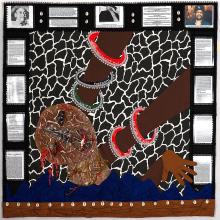Emmett was resistant to the long list of rules and taboos that governed interactions between blacks and whites. He wowed the local children with stories of his white girlfriends back home, and he was brave enough to wolf whistle at the white woman working at the local general store. Stories of Emmett’s behavior toward Carolyn Bryant, the young woman at the general store, spread throughout Money. Her husband soon heard about the incident, and he decided he needed to teach Emmett a lesson.
Early in the morning on August 28, Roy Bryant and his half-brother J.W. Milam went to the home of Emmett’s uncle Mose Wright and demanded that Emmett come with them.
Three days later, Till’s body was found in the Tallahatchie River. His skull was deformed by a brutal beating, and one of his eyes had been gouged out. He had been shot and thrown into the river with a heavy fan blade attached to his neck with barbed wire.
Bryant and Milam were brought to court for Till’s kidnapping and murder, but after only an hour of deliberation, the all-white jury returned its verdict: not guilty. A year later, Bryant and Milam admitted to murdering Till in an interview with Look magazine.
In the days and weeks following Emmett Till’s murder, the act of violence was condemned by local media and white public figures. However, as the case received increasing national attention, Northern media outlets began attacking the climate of racial injustice in Mississippi, and locals began to indignantly defend Bryant and Milam. Black media outlets played a large role in expanding the notoriety of Till’s murder. When Jet magazine published a photo of Emmett’s disfigured remains, outrage spread throughout black communities nationwide.
The media coverage became a war between those calling for justice and those defending the status quo. No matter what side a person took, the battle could not be ignored because it had made its way into the family living room. Television made inequality visible in a way it never had been before. In a way, the tragedy served as a unifying force, concretizing and focusing the righteous anger of black people and other proponents of equality. This anger had been living beneath the surface and building in intensity for generations.
Till’s murder is considered to have set the Civil Rights Movement in motion. When Rosa Parks refused to give up her seat on a Montgomery city bus, she was thinking of Emmett Till, she has said. After decades of segregation, humiliation and fear, black people in the South had decided that enough was enough.
This summer marks the 50th anniversary of Freedom Summer-- when a diverse group of students and young activists mobilized en masse to travel to the regions where racism ruled and fight for voting rights and desegregation. Freedom Summer showed us the important role young people play in inciting action and creating change. It demonstrated the power of a community united, even if that community is brought together not by geography but by a shared passion and common goal.
Freedom Summer and the Civil Rights Movements had many successes: the end of de jure segregation, the reduction of discriminatory voting practices and the turning of national sentiment in favor of racial equality. However, the challenges faced by the participants in these movements are not unknown to those still fighting for racial equality today. Discrimination continues to fester in the workforce, the real estate market, the classroom, the voting booth and the newsroom. We still turn a blind eye to injustice. We still have a soft spot for the status quo. It was only one year ago when our Supreme Court struck down key provisions of the Voting Rights Act of 1965. This action has the potential to jeopardize disadvantaged Americans’ right to vote. 1964 was also the year that President Lyndon B. Johnson declared a war of poverty in America, enacting legislation meant to tackle the national poverty rate. However, wealth disparity in our country is on the rise, and Americans living in poverty are disproportionately people of color. A discriminatory penile system and the “school to prison pipeline” have led to the mass incarceration of black men and permanent barriers to voting and employment.
Three months ago, the kidnapping of more than 300 young women in Nigeria by an extremist group led to international outrage and the explosion of the hashtag #BringBackOurGirls. The kidnapping was an attack on the education of women. Now, as the outcry on social media dies down, the girls remain in captivity, and their families continue to fight for their safe return.
There are more people enslaved today than at any other time in human history, but their suffering goes largely unheard.
Just like the murder of Emmett Till, these realities deserve our righteous anger.
While the fight against modern slavery is gaining momentum worldwide, it has not yet matched the Civil Rights Movement in terms of national attention, support and action. It may seem like that modern abolitionism has not yet had its Emmett Till, but in reality there have been millions of Emmett Tills, millions of young men and women who have had their lives taken and their freedom stolen. As long as slaves remain nameless faces and slavery a nebulous concept far from our everyday lives, we will continue being content with the status quo.
Tatum Hunter, Public Relations Intern


